The Acer Nitro 5 Review: Renoir And Turing On A Budget
by Brett Howse on October 9, 2020 8:00 AM ESTDisplay Analysis
One of the weak spots on Acer’s Nitro lineup has been the display in the past, so we will see how the new model fares. The base offering is a 15.6-inch 1920x1080 IPS display, offering a 60 Hz refresh rate, and on higher-tire models there is a 144 Hz offering available, although with the limited GPU offerings, that is likely overkill for this machine. There is no G-SYNC available either, so although 144 Hz displays are fantastic, the Acer Nitro 5 likely won’t be able to achieve that kind of framerate at its native resolution anyway.
There is no touch support, so there is no reflective glass over the top of the display, so it works quite well in most environments. The resolution provides a relatively meagre 141 pixels-per-inch, but with the gaming focus, this is 100% the correct resolution to offer.
To see how the Acer Nitro 5’s display performs, we test it using Portrail Display’s Calman software suite with a custom workflow. Brightness and contrast measurements are done with the X-Rite i1Display Pro colorimeter, and color accuracy testing is done with the X-Rite i1 Pro 2 spectrophotometer.
Brightness and Contrast
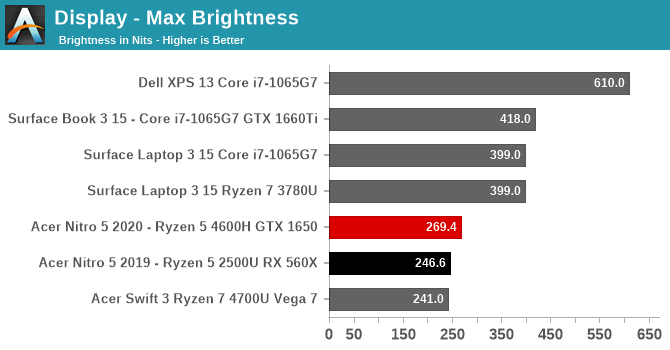
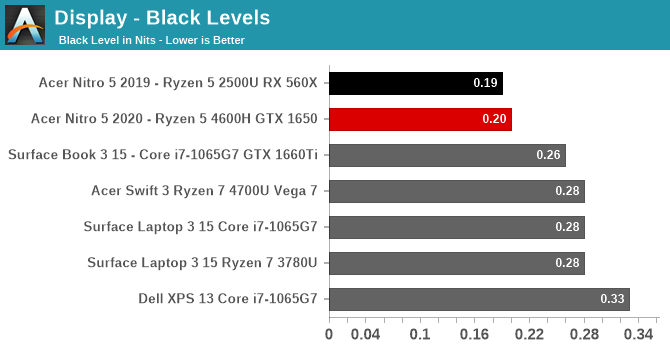
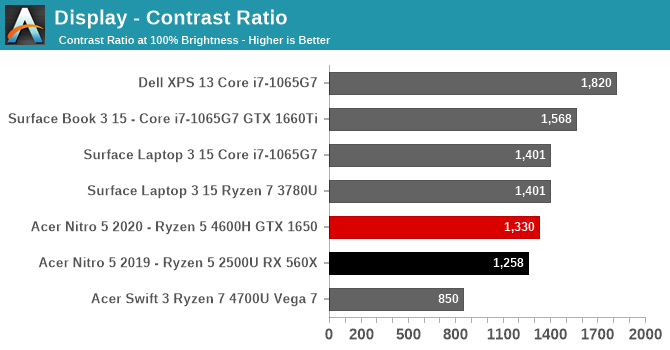
To hit a price target, one of the first areas generally cut is the display backlighting, and that is certainly the case here. At just 260 nits of peak brightness, the Acer Nitro 5 is one of the least-bright displays we have tested recently. That being said, it does offer relatively good black levels, so the overall contrast ratio is very solid at 1300:1.
Grayscale
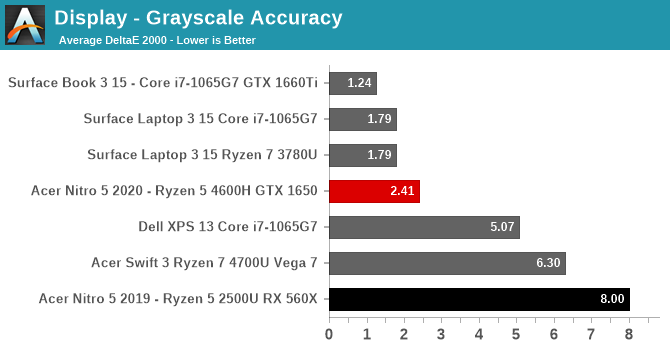
At 200 nits brightness, the grayscale was very impressive on the Nitro 5, with very even red, green, and blue coloring to the white levels. The overall result did not go over the 3.0 level at any point, and the average was just 2.4 dE2000, which is quite good.
Gamut
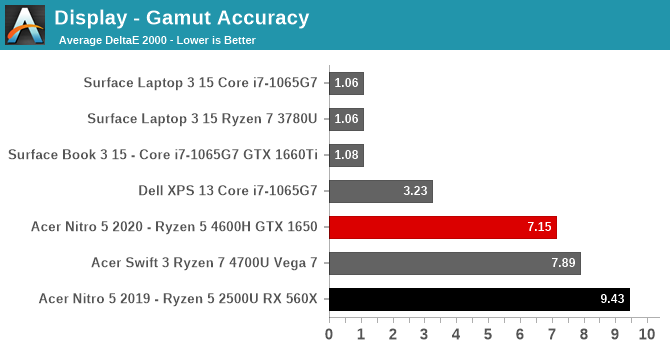
Unfortunately for the Acer Nitro 5, the good grayscale is not backed up by good color accuracy. The Nitro 5 backlighting is not only dim, it can not even get close to covering the entire sRGB color gamut. The blue values are very undersaturated at 100% levels, but red and green are both unable to hit the correct target either, so the secondary colors are quite far off the mark as well.
Saturation
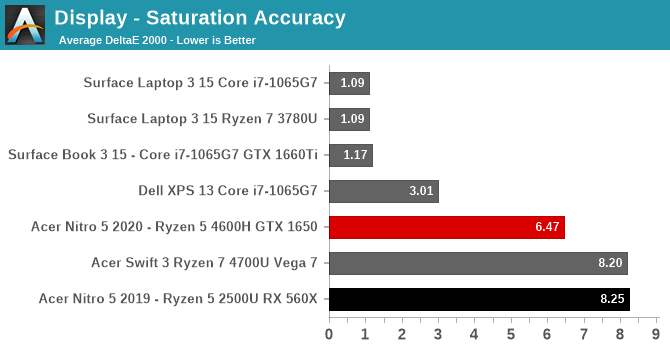
Gamut tests the color accuracy at 100% levels for the primary and secondary colors, and the saturation test does the same thing but at 4-bit steps from 0% to 100%. The blue levels are some of the worst results we have seen in years, with a peak error level of almost 17. For reference, error levels of 3.0 are considered accurate, and under 1.0 is considered impossible for the eye to distinguish.
Gretag Macbeth
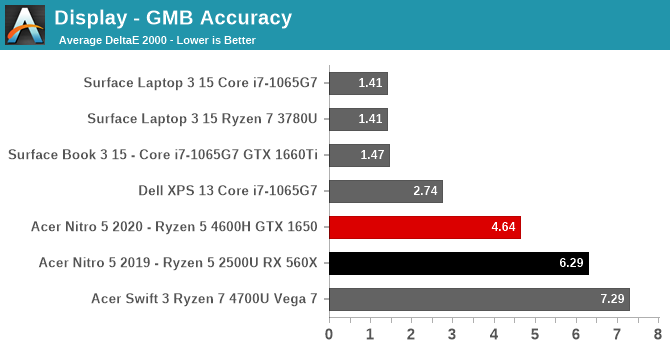
The Gretag Macbeth swatch tests not just the primary and secondary colors, but many others as well, including the important skin tones. With the display unable to achieve the full sRGB gamut, the GMB results are unsurprisingly poor. The average error level is helped by reasonable grayscale, but most of the other colors are quite far off.
Colorchecker
The colorchecker tests a sample of colors, and displays the target color on the bottom with the measured color on the top, to give a visual indication of the inaccuracy of the display. This is a relative result, as any errors in your own display will change the output, but it is still a handy way to more easily interpret the error levels shown above. It is not very pretty for the Acer Nitro 5.
Display Conclusion
Going into this review, there were not high hopes for the display. It is an area where Acer has found room to keep costs down in the past, and if we are being honest, it is an area where you expect less than ideal results in a budget-focused design. That being said, $300 iPads and $500 Surface tablets ship with full sRGB displays that are calibrated per-device. This display is fine for what it is. It is an IPS display, with good viewing angles, and at least on the review unit, good white values, but although some slack must be given Acer due to the tight budget on this device, it is still a bad display.















50 Comments
View All Comments
cfenton - Friday, October 9, 2020 - link
The screen is such a big compromise on a laptop. I wish there was an option to pay a bit more and get something decent.I know it's kind of weird, but this looks like it would make a decent HTPC. It has lots of power and a new GPU for media playback.
ingwe - Friday, October 9, 2020 - link
Yeah this screen makes it DOA to me. Such a shame they cut that corner as it really separates a decent laptop from a great laptop.edzieba - Friday, October 9, 2020 - link
Seriously, 61% sRGB? How on earth do you even FIND an IPS display with primaries that far off?!Otritus - Friday, October 9, 2020 - link
I recall an entry level laptop with amd having a 38% sRGB 60hz 1080p 15.6 in screen. That's more inaccurate than not!meacupla - Friday, October 9, 2020 - link
Consumers need to realize that panel type ≠ inferred qualityVery high quality TN panels have good enough color reproduction, but still not great viewing angles.
Very poor quality IPS panels look like garbage, and look like garbage at any angle.
meacupla - Friday, October 9, 2020 - link
Just to be clear I don't mean to let Very poor quality TN panels off the hook either.Very poor TN panels have extremely awful color reproduction, but are also combined with atrocious viewing angles that invert colors inside of 50cm viewing distances.
So, as awful as this IPS panel is, it's still infinitely better than an equally very low cost/quality TN panel.
sonny73n - Saturday, October 10, 2020 - link
I just got an laptop for less than $780. To my surprise, its IPS display has no backlight leaks even in the dark. I won't mention the brand because some of you may start the politic bullshit but here's the specs:Ryzen 4700U, 16GB DDR4 RAM, 512GB PCIE SSD, 14" 1080p 100% sRGB display, fingerprint sensor on the power button and backlit keyboard.
The companies behind those brands that allowed to sell in the US must've thought that most consumers are pretty stupid - all their midrange and budget devices are garbage.
DiHydro - Sunday, October 11, 2020 - link
Toshibakmmatney - Friday, October 9, 2020 - link
I bought an Intel version of this laptop last year - paid $550, so it was the lowest end model and I'm certain had this same display. The screen isn't that bad - much better than other laptops I had looked at. In fact, I had originally purchased an HP budget gaming laptop on black Friday, but the TN screen was so horrible I had to return it. By comparison this screen was awesome. I'm real picky about screens - my normal driver is a Dell Mobile Precision with an expensive color calibrated display. This screen was not as good, but I have no problems with it.lightningz71 - Friday, October 9, 2020 - link
I wish that the 1650ti version was available for testing as well. I've seen a few comparison benchmarks online, but not as rigorously done as these.Also, it looks like the 4800h version with the 1650ti and improved screen might be a decent foundation for a long term machine. Being able to add a 2.5 inch ssd as a boot drive, and then get two fast NVME drives to raid together to hold the game files, you could have a convincing mobile machine for the new titles coming out for the next console generation. It would be able to keep up with the higher data throughput demands, have 8 real cores, and a similar amount of memory, just no ray tracing.